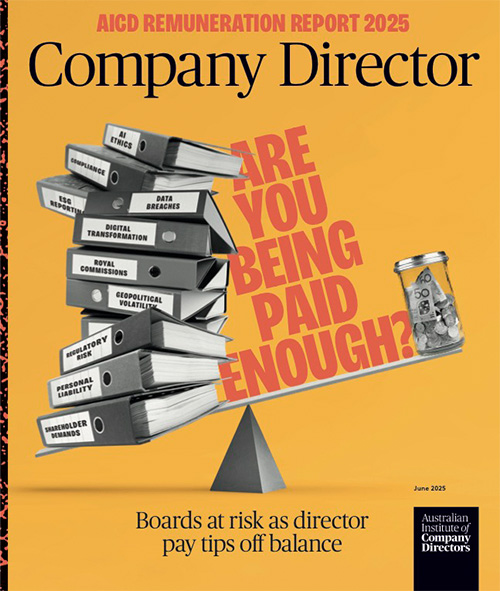Collaborative problem-solving is more important than ever in an increasingly complex world. Genevieve Hawkins GAICD, a health professional turned “transformation executive” and author of Shrinking Elephants, explains how conflict can be fundamental to good governance.
1. Sit with discomfort
People generally either avoid conflict until it explodes or charge into it like a bull in a china shop. But rather than hide behind ideals of harmony or become aggressive, directors should sit with the discomfort of a range of different perspectives on a particular issue and collectively find a way forward. Whatever you do, don’t ignore the elephants in the room. They will only grow.
Have the courage to be the lone voice. Be the first person who doesn’t stick their head in the sand and say, “We see this problem from very different perspectives.” We need to understand this collectively by moving around these different perspectives. Ultimately, if we think about conflict as the discomfort that comes from differing opinions, then actually experiencing that discomfort is the way we unlock value creation for organisations.
2. Listen to every voice
We all wear our own lenses and bring something unique to the table. Having a common language and a framework where all voices are heard makes it easier to name the elephants in the room and move past them. It’s also crucial for increasingly diverse boardrooms that deliberately draw on a range of experiences and perspectives.
This can help to safeguard against a bloc of directors who dominate discussion and think the same way, which can cause “quiet conflict” among peers, who don’t feel comfortable raising an alternative view.
When our framework says we need to hear all voices, it’s easier to say, “I want to hear from a couple of people who’ve remained quiet.” It’s really important that every voice is heard.
Board chairs play a vital role here, by leading the orchestration of debate among board members with differing views.
3. Be curious
Everyone loves interesting investments and strategies, but engaging with all the issues the board is tasked with is key for directors to unlock an organisation’s potential. Ultimately, curiosity is at the heart of using conflict for good — curiosity about the ecosystem we’re operating in and other people’s perspectives on that ecosystem.
Always remain curious about how conflict makes us react. By being conscious of the views being presented and realising they might have had a defensive reaction, directors can ask, “What is going on here? Why am I feeling this way? I need your help to work through it and get out the other end with both of us understanding each other more.” Having a framework gives directors the capacity to flag when they are feeling discomfort about the discussion or their reaction to it.
4. Don’t assume you’re always right
To believe your opinion is the only correct one can lead to a stalemate of two people or parties insisting that their view is the path to follow. That’s where you shut down the capacity to unlock value.
By taking in other perspectives, the board can find some tweaks that might make a course of action even stronger.
You always need one person with the generosity to say, “I’m going to suspend my view of being right,” and literally say, “OK, your life experience has been different to mine, walk me through some of the things you’ve seen.”
Then you say, “OK, I hear you. Now can you come around to my side and I’ll walk you through my experience? Then let’s put them on the table together and decide what we’re doing.
5. Set a healthy tone for all
When quiet conflict continues to build, it makes us increasingly uncomfortable, which impacts our health. By embracing and talking about conflict it not only helps us, it also helps to create a mentally healthy dynamic in the boardroom — and in turn, the entire organisation.
If the boardroom is made up of a really effective team of people who can talk about difficult issues with a consistent framework, that sets the tone for navigating conflict within the organisation, which ultimately improves collective mental health. Fundamentally, we all need to feel like we belong, that we’ve been seen, that we’ve been heard and that we matter.
When we ensure we feel a strong sense of connection, and we have a capacity to hear each other and to understand and respect each other’s perspectives, that’s a healthy boardroom — one which people want to be a part of.
This article first appeared under the headline 'Peak Performance' in the June 2025 issue of Company Director magazine.
Latest news
Already a member?
Login to view this content


